| | |
- "They were in the wrong place at the wrong time. Naturally, they became heroes."
- ―Leia Organa Solo
The Alliance to Restore the Republic, also known as the Alliance to Restore Freedom to the Galaxy, the Rebel Alliance, or informally as the Rebellion, was a loose alliance of planetary, system, and sector-level insurrectionist factions. They were generally united in common cause, against a common enemy in the form of the Galactic Empire. In order to achieve their primary goal in restoring the former Galactic Republic, the Alliance aimed to remove Emperor Palpatine from power, and his hegemonic New Order from the galaxy. Members of the Rebellion were known as "Rebels," "Rebs," or "Rebel scum" by stormtroopers and other Imperials.
The origins of the overall anti-Imperial movement dated back to 19 BBY, shortly before the Galactic Republic's transformation into the Empire. Some of the Alliance's core founders, such as senators Bail Prestor Organa and Mon Mothma of the Loyalist Committee, joined the Delegation of 2000 in its opposition against the authoritarian leadership of then-Chancellor Palpatine. In 18 BBY, barely a year into the Empire's existence, military resistance had already been formed in opposition to the new regime; one of which was a group of insurgents known as The Eleven, joined by the fugitive Jedi Ferus Olin. By 2 BBY, several resistance groups were unified into a single rebellion, thus creating the Rebel Alliance. Ironically, the Rebel Alliance's formation was secretly instigated by the Order of the Sith Lords. In what was supposed to be a plot for drawing the Emperor's enemies out from hiding, the Sith Lord Darth Vader ordered his secret apprentice, Starkiller, to organize various rebels and dissidents into a large resistance movement. After Starkiller was betrayed by his Master, however, the former apprentice sacrificed himself to ensure the survival of the Rebel leaders.
Hence, the Galactic Civil War erupted with the fledgling Alliance challenging the Empire for control of the galaxy. Rather than challenging the Empire directly, the rebels fought a war of attrition, destroying key Imperial targets and liberating numerous worlds. Though vastly outnumbered in manpower, starships, weapons and various other resources, the Rebels themselves possessed a strong will to fight. By and large, the Alliance was composed of well-trained soldiers and brilliant commanders, some of whom dedicated their lives to the Rebellion after defecting from the Empire due to the atrocities that were committed by the Imperial regime. After securing early victories against the Empire on Kamino and Toprawa, the Rebels achieved one of their most significant triumphs at the Battle of Yavin, in which a Rebel pilot named Luke Skywalker destroyed the Imperial battlestation code-named Death Star. In 4 ABY, roughly four years after the destruction of the first Death Star, Emperor Palpatine and Darth Vader both perished during the Battle of Endor.
In the wake of their victory at Endor, the Rebel Alliance reorganized itself into a more formal state that was originally known as the Alliance of Free Planets before its reorganization into the New Republic. Ultimately, the New Republic was later remade into the Galactic Alliance, a more autocratic union that united much of the galaxy under a republican form of government, just as the Old Republic had done in its time, though such a system ultimately could not withstand the threats it faced, and like the Old Republic was laid low by the Sith.
History[]
Early foundations[]
- "Vote for Palpatine. Vote for the Empire. Make Mon Mothma vote for him too. Be good little Senators. Mind your manners and keep your heads down. And keep doing all those things we can't talk about. All those things I can't know. Promise me, Bail."
- ―Padmé Amidala, to Bail Organa, during the Declaration of a New Order
In the final days of the Galactic Republic, certain senators, such as Padmé Amidala of Naboo,[24] Bail Organa of Alderaan[25] and Mon Mothma of Chandrila[3] grew increasingly concerned over the constitutional amendments that weakened the legislature and empowered the executive branch with near dictatorial authority.[23] Although a majority of the Senate supported such alterations to the government's overall structure because of the Separatist Crisis and subsequent Clone Wars, both of which threatened to divide the galaxy in half between the Republic and the Separatist insurrection,[26]
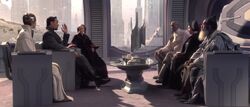
A group of Republic loyalists discuss their options for opposing Palpatine's policies.
The Rebellion against the Galactic Empire began as a peaceful movement by a political minority, known as the Delegation of 2000, within the Galactic Senate.[23] the members of the Delegation of 2000 felt that the amendments were too radical, unconstitutional, and generally detrimental to the future of the Republic. Despite the fact that the Separatists were on the verge of defeat in 19 BBY, the final year of the Clone Wars, most senators continued to invest even greater authority within Supreme Chancellor Palpatine. Fearing that the Republic would inevitably drift into an authoritarian regime, the Delegation of 2000 formally presented their concerns to the Chancellor with the request for the relinquishing of his emergency powers.[23]
Unknown to the Delegation of 2000, however,[23] Chancellor Palpatine was secretly a Sith Lord named Darth Sidious. For a thousand years, the Order of the Sith Lords waited and plotted for the time when they would reassert their dominance over the galaxy, specifically by overthrowing the Galactic Republic and the Jedi Order. As Palpatine, Sidious spent decades infiltrating the political hierarchy of the Republic. His election as chancellor, the creation of the Kamino clone army, the escalation of the Separatist movement and the outbreak of the Clone Wars were all factors in the Sith's plot to seize control of the galaxy.[27]
Three years of galactic warfare strengthened Chancellor Palpatine's position as a public figure. Public support for his leadership in the Clone Wars remained strong throughout the conflict; he was immensely popular with the Republic citizenry, and the Senate majority remained firmly committed to its leader in regard to his policy-making decisions. Yet the systematic suppression of thousands of years of Republic traditions and democratic ideals convinced Amidala, Organa, and a group of like-minded senators that the Republic was in danger of losing its core principles for the sake of security. The passing of the Sector Governance Decree all but made the Senate obsolete; entire sectors would be controlled by a cabal of military governors—otherwise known as Moffs—hand-picked by Chancellor Palpatine.[23]
Thus, the Delegation responded with a petition of two thousand signatures from members of the Senate who objected to the Moffs' virtual usurpation of the Senate's responsibilities. They also hoped that their collective opposition would force Chancellor Palpatine to restore the Republic to its pre-war state. The Delegation's cause to prevent further amendments to the Constitution was ultimately lost when Palpatine issued Order 66, a contingency directive that caused the Republic clone soldiers to betray and murder their Jedi officers.[23] Palpatine then called for a special session of congress, in which he presented a fabricated recollection of a Jedi assassination attempt on his life. The invention of a "Jedi rebellion" presented Palpatine with the justification for his ultimate modification to the Republic; he declared himself Emperor of the first Galactic Empire.[28] Amidala and Organa, two of the leading members in the Delegation of 2000,[23] watched in abject shock as their colleagues cheered the end of democracy with thunderous applause.[28]
One of the earliest orders of business for the Emperor's new regime was the targeting of the Delegation of 2000. Charged with sedition and high treason, many who had signed the petition in opposition to Palpatine's policies were imprisoned, executed or forced into exile. After the Empire conquered and razed the Wookiee home planet of Kashyyyk, many more members of the Delegation withdrew their support out of fear for their lives. However, Organa and Mothma were both able to avoid persecution for a time.[29] Prior to Amidala's death, the Naboo senator advised her political allies to oppose the Emperor in secret while feigning obedience.[23]
Armed resistance[]
- "The Empire maintains order, and people like you disrupt that order."
- ―Sarkli

The assassination of Queen Apailana brought an end to Naboo's nascent rebellion against the Empire.
Emperor Palpatine's strategy for the enforcement of the New Order was based on brutal tactics, such as the implementation of the fear of military force in order to discourage ideas of insurrection. The rise of the Galactic Empire was not supported by all member worlds. One of the first planets that attempted to resist Imperialization was the Emperor's own homeworld of Naboo, ruled by Queen Apailana at the time.[31] Under Apailana's leadership, the Naboo continued to celebrate the memory of the Republic, rather than acknowledging the Empire's rule over the galaxy.[32] The Queen also began considering military options that involved sheltering Jedi fugitives. Such actions were discovered and interpreted as signs of rebellion by Imperial Intelligence, and thus the Empire retaliated with the deployment of armed forces to Naboo. The 501st Legion, an elite division of clone stormtroopers under the command of the Sith Lord Darth Vader, assaulted the capital city of Theed in 18 BBY. Although the Queen's security detail was augmented by the Jedi, they were ultimately unable to repel the 501st. The city fell to the Imperials, its garrison was destroyed, and Apailana was assassinated during the battle. In the following years, the Empire repeatedly overthrew disloyal governments through force, often relying on Vader's 501st Legion for enforcing the Emperor's rule where ever it was opposed.[31]
In the same year, a group of disillusioned civilians publicly protested against the Empire's despotic policies, including its high taxation of Ghorman. They staged their protest on the landing platform where Moff Wilhuff Tarkin's ship was set to arrive. Their attempt to block Tarkin's arrival did not succeed; in what became known as the Ghorman Massacre, the Governor simply landed his vessel on the platform, killing hundreds of activists in the process. This event was interpreted as a tragedy by outraged sympathizers who also disagreed with the direction of the Empire. Jan Dodonna and other career officers whose service records dated back to the Republic either resigned or retired from Imperial service. The incident also convinced Bail Organa that the Empire was a malevolent government. Yet with so many disorganized and uncoordinated rebel cells, Organa remained convinced that the time was not right for open rebellion.[4] He continued to meet in secret with his closest political allies, senators Mon Mothma and Garm Bel Iblis of Corellia in the Cantham House on Coruscant in order to discuss options for creating their own rebellion against Palpatine. Mothma, however, was forced to flee into exile after being labeled a traitor to the Empire due to her outspoken criticism of the New Order.[33] Iblis's failure to hide his own discontent with the Empire also drove him underground in order to escape persecution.[16]
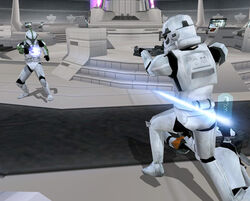
The Imperial 501st puts down the clone rebellion on Kamino.
Further incidents of armed resistance against Imperial rule involved remnants of the fallen Separatist movement. Gizor Dellso, a Geonosian war criminal who survived the Clone Wars, fled into hiding on Mustafar. Utilizing an abandoned droid factory, Dellso constructed his own private army of battle droids for the sole purpose of reviving the Separatist cause. Before his plot could be carried out, the 501st Legion attacked Mustafar and destroyed his army; Dellso died during the fighting shortly before his factory was destroyed by Imperial Star Destroyers via orbital bombardment.[31]
Another insurrectionist plot against the Galactic Empire was later discovered on Kamino, the world that was responsible for the creation of the Republic clone army. A rogue group of Kaminoan cloners resented the Empire's control of their homeworld. Throughout the first decade of the Empire, they secretly engineered and trained an army of rebel clone troopers, all of whom were programmed with absolute loyalty to Kamino.[34] After Darth Vader uncovered the scheme, he dispatched the 501st—under the leadership of the bounty hunter Boba Fett—to the planet. The subsequent battle resulted in the destruction of the rogue clones and their creators, as well as the fall of Tipoca City and all of Kamino. The incident was classified and kept hidden from public records, but Palpatine decided that an army of clones from one genetic template was too susceptible to corruption. Hence, both the Imperial Army and Stormtrooper Corps were heavily diversified with the introduction of new clone soldiers who were based on a variety of different templates.[31] The Empire later redirected the clone program to pursue other projects, and thus the military was compensated with an increase in the recruitment of birth-born Humans as enlisted troopers.[35]
Darth Vader's secret apprentice[]
- "The historical records will claim that the Rebel Alliance was born on Corellia. That is a documented fact, but the truth is this: the Rebel Alliance was born in the Scarl system… aboard Darth Vader`s personal starship, the Executor."
- ―PROXY
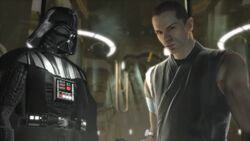
Darth Vader orders his secret apprentice to forge a rebellion against the Empire.
Years before the formation of the Rebel Alliance, Darth Vader discovered a young Human child named Galen Marek during an attack on Kashyyyk.[37] Marek's father and mother, Kento and Mallie Marek, were both trained members of the Jedi Order.[17] Thus, he possessed an incredibly powerful connection to the Force. Realizing the boy's potential was too great to discard, Vader abducted Marek and indoctrinated him into the ways of the Sith as a secret apprentice. As time passed, Marek developed into a highly efficient Sith assassin, known only to a select few by the codename Starkiller;[16] his past and former identity were ultimately forgotten as he had been too young to remember what his life was like before falling under Vader's relentless tutelage.[37] As his training neared completion, Starkiller was all but a true Sith. Under the Rule of Two, however, only two Sith Lords were allowed to exist.[38] Starkiller's Master still answered to another Master, the Galactic Emperor. Ultimately, Vader assured Starkiller that they would eventually unite their powers to overthrow Palpatine in order to rule the galaxy as master and apprentice.[2]
In 2 BBY,[36] Darth Vader commanded Starkiller to search the galaxy for various rebels and dissidents who opposed the Galactic Empire. He was then required to unite them into a single rebellion that would plunge the Empire into a state of civil war. Vader reasoned that an insurrection created the best opportunity to assassinate the Emperor, especially because his attention would be focused primarily on destroying the rebels. Hence, the apprentice embarked on his mission in earnest, and eventually brought Jedi Master Rahm Kota, the only known survivor from Marek's missions to exterminate any Jedi who survived Order 66, and Bail Organa into the fold after earning their trust. Through Organa, Starkiller also made contact with the fugitives Mon Mothma and Garm Bel Iblis. Organa's adopted daughter, Princess Leia Organa also pledged her support to the nascent rebellion while still serving as her father's successor in the Imperial Senate.[2]
Birth of the Rebellion[]
- "We agree that the time for diplomacy and politics has passed. It is now time for action… therefore let this be an official declaration of rebellion! Today, we all vow to change the galaxy, and one day the galaxy will indeed be free!"
- ―Bail Organa
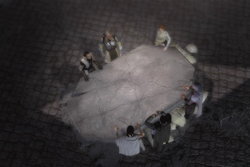
The Rebel Alliance is formed by Starkiller and his allies on Corellia.
Starkiller's fellow subversives were initially resistant to the notion of open rebellion. They felt that the galaxy had to be shown one way or another that the Empire was vulnerable. In accordance with Darth Vader's counsel, Starkiller destroyed an Imperial shipyard that orbited Raxus Prime. As a single Star Destroyer moved to intercept him, the apprentice used the Force to rip the massive vessel from the sky, causing it to crash on the surface below. The symbolic victory had the desired effect as Vader predicted. Starkiller and the senators rendezvoused on Corellia where they ceremoniously proclaimed the birth of the Rebellion, as well as their intentions to restore liberty to the galaxy.[2]
However, Starkiller had been betrayed by the Dark Lord of the Sith. The true purpose of his mission was to gather the Emperor's enemies in a single location so that Imperial troops could arrest them all at once. Darth Vader revealed the truth to his shocked apprentice: he never intended to overthrow the Emperor with Starkiller at his side. After leaving his former assassin for dead, Vader transported the Rebel leaders to the incomplete Death Star where Emperor Palpatine awaited their arrival.[2] Yet Starkiller survived and ultimately renounced his Sith persona, thus resuming the use of his birth name "Galen Marek," recovered from repressed memories of his past.[37]
Marek infiltrated the battlestation and single-handedly slew countless Imperial soldiers before defeating his former Master in a lightsaber duel. With Darth Vader severely damaged and at the apprentice's mercy, Emperor Palpatine urged Marek to assume the mantle of a true Sith Lord by killing Vader in cold blood. Though briefly tempted to pursue his lifelong goal once more, Marek chose to rescue the Rebel leaders by attacking the Emperor. The Rebels escaped with their lives, but Marek was forced to sacrifice his own in order to provide them with enough time to flee the Death Star in the Rogue Shadow.[2]
In the aftermath of Galen Marek's demise, the Rebel leaders reconvened on Kashyyyk where they held a meeting in their fallen leader's childhood home. The Alliance to Restore the Republic was officially realized. At Leia Organa's behest, the Rebels chose to honor the secret apprentice's memory by basing their organization's emblem on the Marek family crest, effectively turning it into a symbol of hope that many beings rallied around during the subsequent Galactic Civil War.[2]
New allies and weapons[]
- "Time to retire those Z-95 Headhunters!"
- ―Raymus Antilles, after the victory at Fresia
The most notable equipment contributions included the defection of some Incom Corporation staff and all relevant material involved in the development of an advanced starfighter, the T-65 X-wing, which was acquired at the Battle of Fresia. With this advanced fighter, Rebel pilots had a clear advantage over the more numerous yet unshielded TIE fighters. With the help of Gial Ackbar, who had recently been freed by Rebel forces from slavery under the Empire, Mon Mothma then secured an alliance with the Mon Calamari, who openly joined the Rebel Alliance and used their renowned skill in ship construction to supply badly needed capital ships that could take on the Imperial Navy. Their considerable fleet of Mon Calamari Star Cruisers gave the newly formed Alliance substantial firepower. Part of the Alliance's strategy was the doctrine of space denial. That is, the Alliance would attack Imperial shipping in hit and run raids; both to disrupt Imperial supplies and operations, and to confiscate desperately needed materials. In these situations, their fighters had hyperdrive capability along prearranged routes which would allow this kind of harassment and escape before the Empire could react.
At the same time, the Rebel Alliance annexed most of the remaining Separatist holdouts. Some remaining Confederate materiel, such as Recusant-class light destroyers, ended up in Rebel hands.[40]
Largely because of their fighting against the Empire, High General Cassio Tagge stated in the history of the Imperial Army in the official field manual for the Imperial Military, Imperial Handbook: A Commander's Guide, that the Rebels, and by extension those who claimed kinship with them, feared order, distrusted prosperity, and hated progress.[41]
Destruction of Alderaan[]

Rebel propaganda efforts after the destruction of Alderaan
- "Continue with the operation; you may fire when ready."
- ―Grand Moff Wilhuff Tarkin, giving the order to destroy Alderaan
Because several key Alliance figures were held prisoner on it after the signing of the Corellian Treaty, the Alliance learned of the construction of the Death Star, an enormous terror weapon capable of destroying an entire planet, intended to secure the Empire's power. An operation headed by Princess Leia was successful in retrieving the schematics of the station, but Darth Vader discovered the act and captured Leia. In an effort to get the young princess to divulge the location of the secret Rebel base, Grand Moff Tarkin threatened to destroy her home planet of Alderaan. Yet even after Leia gave him the location of an abandoned Rebel base on Dantooine, Tarkin ordered the Death Star to fire its primary weapon—a planet-destroying superlaser. Leia watched as billions of her fellow Alderaanians were murdered by the vicious super-weapon. The Alliance would use this act as a propaganda tool to recruit more people into its ranks.[8]
A New Hope[]
- "Remember, the Force will be with you. Always."
- ―Obi-Wan Kenobi, to Luke Skywalker
The Force was with the Alliance. Luke Skywalker, a young man from Tatooine, came under the tutelage of Jedi Master Obi-Wan Kenobi, after stormtroopers destroyed his farm and killed his uncle and aunt. The aged Jedi had been watching Luke for a long time. Knowing his family history and importance to defeating the Emperor, Obi-Wan began training the boy as a Jedi. The duo, along with the droids C-3PO and R2-D2, secured passage on a freighter, Millennium Falcon. With the help of smuggler Han Solo and his Wookiee co-pilot Chewbacca, the group managed to free Princess Leia Organa from the Death Star (only after Obi-Wan sacrificed himself in a duel with Vader) and deliver the plans to the Alliance. As a result, the Alliance succeeded in attacking and destroying the battle station, and also, in Luke, they gained their only loyal member with training in the use of the Force and the skills of the practically extinct Jedi Knights.[8]
Galactic Civil War[]
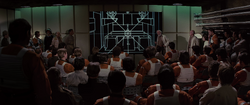
Rebel pilots before the attack on the First Death Star
- "In the past, we'd secretly enjoyed putting down a local insurrection or two, they kept the troops sharp and the Empire feared; but these Rebels were different. They were organized, they were growing, and they were everywhere."
- ―Journal of the 501st
As a result of the Battle of Yavin, the Rebel Alliance gained credibility as a legitimate military opponent to the Empire. Between the effects of the battle and the dissolution of the Imperial Senate, thousands of star systems openly joined the Alliance in the months following the Death Star's destruction.[42] As a result, the Empire began occupying worlds it had allowed to remain untouched earlier, both actions resulting in an escalation of the war.
The Alliance could afford to waste no time following its major victory at Yavin. Following numerous raids on their Yavin 4 base, the Alliance relocated temporarily to a base on Thila while setting up a more permanent establishment on the ice planet Hoth. There were some setbacks, namely Garm Bel Iblis leaving the Alliance following a major disagreement with Mon Mothma to create his own rebellion. This was a blow to the Alliance, though it was offset by the joining of Borsk Fey'lya and his sizable faction of Bothans. Mon Mothma took steps to create a true navy for the Alliance, raising the Mon Calamari Gial Ackbar to the rank of Admiral and appointing him Supreme Commander of the Rebel Fleet. Under Ackbar's leadership the fleet grew in size and ability. Along with the headquarters of the Rebel Alliance, Ackbar's fleet was the most important asset of the Rebellion. During this time Luke, Han, Leia, and their companions proved to be the most valuable Alliance members, performing countless crucial missions.
The ensuing battles around the galaxy were a number of engagements between either side. Many were Rebel soldiers fighting to sabotage Imperial weapons or destroy Imperial facilities. A large number of people were inspired by the defeats of the Galactic Empire to join the Rebellion. However, the might and oppressive nature of the Empire inspired others to join the Imperial Military.
Loss of Hoth[]

A holo memorial honored Rebel pilots who were killed during the Battle of Yavin.
- "Imperial troops have entered the base! Imperial troops have-"
- ―Jobin
The Alliance suffered a setback when Echo Base, Alliance High Command's main base of operations on the ice planet Hoth, was discovered by an Imperial probe droid and overrun by Darth Vader's forces. In the ensuing battle to escape, the Rebels used their large ground-based ion cannon to disable several of the Star Destroyers in orbit, effectively punching temporary holes in the Imperial blockade long enough for Rebel Gallofree transports and other craft to escape the planet. The Alliance was forced to scatter and remain mobile until the end of the war for fear of losing another main base. Therefore the High Command was transferred to the Rebel Fleet, using Ackbar's flagship Home One as their mobile base of operations. This was a dark time for the Alliance with the loss of men and equipment on Hoth as well as being forced into hiding from the Empire. Also, Rebel hero Han Solo was captured while in Lando Calrissian's hospitality on Cloud City, subsequently frozen in carbonite, and sent to Jabba the Hutt on Tatooine by the bounty hunter Boba Fett. Furthermore, the secret shipyards in the Vergesso Asteroids were destroyed by Darth Vader's fleet.[10]
Crucial Victory at Endor[]
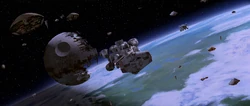
The new Death Star served as the backdrop for the Battle of Endor.
News that a new and more powerful Imperial space station, Death Star II, was nearing completion, forced the Alliance to take its greatest risk. The entire Rebel Fleet was amassed near Sullust, in order to launch an attack on the installation before it could become operational. Most important to the decision to initiate this attack was the knowledge that the Emperor himself was overseeing the final stages of construction on board the Death Star. However, in secret, the Empire had organized its forces there so that when the Rebel fleet was lured in, it would be destroyed. The plan backfired, and the subsequent Battle of Endor was a massive victory for the Alliance. Palpatine was dead; his Death Star destroyed, along with many Imperial warships, including Darth Vader's flagship, The Executor. Darth Vader, who was redeemed by Luke Skywalker, his son, became Anakin Skywalker once again and sacrificed himself to kill Palpatine, saving Luke in the process.[43]
Reorganization into New Republic[]
- "We are no longer the Rebel Alliance. United, we are quite literally, an Alliance of Free Planets. And so shall we remain until the Republic can be restored."
- ―Mon Mothma
About one week after the death of the Emperor at Endor, Mon Mothma declared the Rebellion (which became the Alliance of Free Planets) to be at an end, one month after that, she declared the New Republic to be established as the successor state. The Alliance to Restore the Republic had succeeded—a new Republic was to be born, though in many people's eyes the movement only gained real legitimacy with the capture of Coruscant twice by Rogue Squadron and New Republic forces in 6.5 ABY.
Government and politics[]
The Civil Government[]
- "The Alliance was structured to wage war, not rule in peace. It was a benign dictatorship empowered to lead a Rebellion, not govern a galaxy."
- ―Voren Na'al
The Alliance was divided into the Civil Government and the Military, led by the Chief of State and the Commander-in-Chief, respectively. Throughout the Galactic Civil War, however, the two positions were occupied by the same person, Mon Mothma.[20] The Civil Government was responsible for handling the numerous jobs of any planetary civil government—including protecting the Alliance's peoples, revenue gathering, the maintenance of vital services, and foreign relations and defense. Many of these functions were left to each member world or government of the Alliance.
The Chief of State was the head of the Alliance. Essentially an elected dictator, the Chief of State had virtually unlimited power over the Alliance. Elections were held every two years, though in practice this was only a formality as Mon Mothma had unanimous support amongst the Alliance members. According to the Corellian Treaty, the position of Chief of State "will be abolished when the Emperor is deposed, killed, or resigns his position of power." When this happened, it was the duty of the Advisory Council to assume executive control of the Alliance and convene a Constitutional Convention to form a new Galactic Republic.[20]
Below the Chief of State was the Advisory Council, which was composed of representatives of seven Allied governments who had given the most lives in battle to defeat the Empire. This council was the primary advisory body to the Chief of State, responsible for approving or dismissing the proposals of the Chief of State. Furthermore, the Advisory Council had the right to dismiss a Chief of State with a two-thirds majority vote, providing a check to the powers of the Chief. During most of the history of the Alliance, worlds like Alderaan, Dac, and Sullust were members of the Advisory Council, due to their extreme devotion and high losses of life suffered in Alliance service.
The Alliance Cabinet was the body of Ministers through which the Chief of State could maintain and run the Alliance. Each member was selected by Mon Mothma for their devotion, intelligence, and ability to get things done. The Cabinet was composed of six ministries: the Ministry of Finance, responsible for overseeing Alliance funds; the Ministry of Education, which controlled Alliance Civil Intelligence and distributed propaganda; the Ministry of State, which handled relations with other non-member governments; the Ministry of Industry, which controlled all Alliance factories and production; the Ministry of Supply, which maintained supply chain for the Alliance government; and the Ministry of War, which advised Chief of State on directing Alliance military forces and controlled the Alliance High Command.
The Allied Commands[]
The Alliance Allied Commands were the individual local governments of planets, sectors, organizations, and groups that were members of the Alliance.[20] Each Allied Command varied slightly depending on how each member world was organized, though in practice Allied Commands mimicked the structure of the Alliance government. Allied Commands ranged from member worlds like Mon Calamari or Alderaan to whole sectors like Atrivis or Churnis.
Alliance Military[]
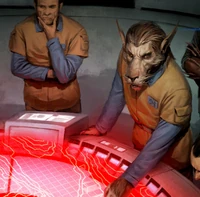
A Bothan Rebel High General.
- "Everyone in the Rebellion is here for a reason. Everyone was affected by the Empire in one way or another. Everyone has a story to tell. Most of them are tragic."
- ―Wedge Antilles
The Alliance Military was charged with defeating the forces of the Galactic Empire and bringing down the Emperor's reign of terror, a task to which all Rebel military personnel pledged themselves. Its members variously included Republic Loyalists, former Separatists, and Imperial defectors. The Alliance Military's civilian leaders were the Commander-in-Chief and the Minister of War. Below them was the Chief of Staff, who worked between the Commander-in-Chief and the seven Supreme Allied Commanders of Alliance High Command. High Command's structure was an odd amalgam reflecting the Rebel military's reliance on the centralized Alliance Fleet, and Alliance Starfighter Corps, local military forces, and clandestine resistance cells.[20]
Fleet Command controlled the Alliance Fleet, with Admiral Gial Ackbar as Supreme Commander from 0 ABY. The Alliance Starfighter Corps answered to Starfighter Command, which was nominally subordinate to Fleet Command, though this was rarely the case in reality as the Alliance came to depend heavily on starfighters as its primary combat force in its early years, though from 0 ABY tactical control of starfighters was assigned to fleet elements or the Sector Forces.[20]
Special Forces Command controlled the Alliance Special Forces, the most capable soldiers of the Alliance Army. The SpecForces were a flexible backbone for the entire Rebellion, with barracks regiments acting as specialist support elements for the Fleet and Sector Forces, or guarding High Command's main bases, while temporary task forces conducted most fighting missions. The SpecForces were routinely used to buttress the weakness of Sector Forces.[20] Ordnance and Supply and the Support Services handled military procurement, transport, and logistics, while the Chief of Intelligence controlled Alliance Intelligence.
Sector Command oversaw the Alliance's thousands of Sector Forces, whose ground forces formed the non-Special Forces element of the Alliance Army. Sector Command generally granted the Sector Forces great leeway in conducting operations in their sectors. The Sector Forces in principle belonged to the Allied Commands, though High Command claimed supreme military authority over them where necessary. Sector Command would sometimes ask individual Sector Forces to detach ships and troops to the central Alliance Fleet for crucial operations.[20]
Astrography[]
Bases[]
- Haven Base on Arbra
- Hidden Rebel Base on Corellia
- AX-235 in the Cron Drift
- Dantooine base on Dantooine
- Endor Station on Endor
- Golrath Station on Golrath
- Echo Base on Hoth
- Polis Massa Base on Polis Massa
- Tak Base on Talay
- Anchorhead Base on Tatooine
- Vergesso Base in the Vergesso Asteroids
- Great Temple on Yavin 4
Alliance worlds[]
Though the Rebels lacked the resources of the Empire, they did control planets.
Major members[]

A meeting of four prominent leaders of the Rebellion: Gial Ackbar, Garm Bel Iblis, Mon Mothma and Bail Prestor Organa
- Gial Ackbar—Admiral, Supreme Commander of the Alliance Fleet
- Wedge Antilles—Commander, Leader of Rogue Squadron following Luke Skywalker's departure
- Walex Blissex—General and key engineer
- Lando Calrissian—General, Commander of starfighter forces during Battle of Endor
- Chewbacca— Han Solo's first mate and key member of his rescue from Jabba's Palace
- Airen Cracken—General, Supreme Commander of Intelligence
- Jan Dodonna—High General, Supreme Commander of Starfighter Command, Commander of Massassi Station on Yavin IV and a Alliance Military Advisor
- Juno Eclipse—First Captain in the Alliance, Commander of the Salvation
- Borsk Fey'lya—Political Advisor; a leader of the Bothan Spynet
- Senator Garm Bel Iblis—Senior General, Co-founder
- Ylenic It'kla—Jedi Knight, Co-founder and Bail Organa's adviser (Deceased - Perished in the Destruction of Alderaan) †
- Bob Hudsol—General, Commander of resistance forces in Bothan Space
- Obi-Wan Kenobi—Jedi Master and one of the earliest Alliance Hero's (Deceased - Sacrificed himself during his rematch with Darth Vader aboard the Death Star) †
- Rahm Kota—Founder, Commander of his own Militia that helped form the Rebellion, General and Jedi Master
- Crix Madine—General, Supreme Commander of Special Forces
- Galen Marek—Founder, Leader (Deceased - Sacrificed himself to save the other leaders aboard the Death Star I) †
- Pharl McQuarrie—General, Advisor to resistance forces on Ralltiir
- Senator Mon Mothma—Chief of State and Commander-in-Chief, Co-founder
- Ral'Rai Muvunc—Minister of Supply and Supreme Commander of Ordnance and Supply
- Ferus Olin —Jedi Knight and Early Founder (Deceased - Killed by Darth Vader) †
- Senator Bail Organa—Co-founder, Alliance Military Advisor and a important leader of the Rebel Alliance (Deceased - Killed in the destruction of the planet Alderaan) †
- Qu Rahn—Jedi Master and General (Deceased - Killed by Jerec) †
- Carlist Rieekan—General, Commander of Echo Base on Hoth
- Ristt—General, Commander of Ring Base
- Roons Sewell—General, Former Commander of Massassi Station on Yavin 4 †
- Corwin Shelvay—Former Jedi Knight and Commander.
- Echuu Shen-Jon—Jedi Master and General (Deceased- Killed by Darth Vader) †
- Col Serra—Commander of Renegade Squadron
- Rachi Sitra—Jedi Knight and Commader.
- Luke Skywalker—General, Former Leader of Rogue Squadron and Jedi Knight
- Leia Organa—Minister of State, Senior Diplomat, Senior General, and a Alliance Military Advisor[source?]
- Han Solo—General, Commander of special forces team sent to Endor
- Starkiller; Repentant dark Jedi. (Cloned from the original Galen Marek by Darth Vader)
- Tardi—Minister of Finance †
- Vanden Willard—General, Commander of Delta Base on New Kisge
- Vernan—General, Former Supreme Commander of Intelligence †
- X2—Commander of Grey Squadron and Jedi Knight
Command Structures[]
Supreme Allied Commands
- Fleet Command
- Ordnance and Supply Command
- Starfighter Command
- Support Services
- Intelligence
- SpecForces Command
- Sector Command(s)
Behind the scenes[]
The Rebel Alliance was the main protagonist faction of the original trilogy of Star Wars, as well as of further stories in both the Legends and canon continuities. When writing the film, George Lucas loosely based the Rebel Alliance on the communist guerrilla group Viet Cong during the Vietnam War, and the Galactic Empire primarily on the United States at that time, albeit slightly disguised because the Vietnam War was still ongoing when he penned The Star Wars in 1973. This was largely inspired by his earlier role in the creative process of the film Apocalypse Now.[47][48][49][50] When James Cameron pointed out how the Rebels were similar to the Mujahideen and Al Qaeda in their technically being a terrorist group, Lucas indicated that that had been his exact intention when writing the films, while adding that it was rooted in anti-colonialist thinking.[51] The Rebellion's tactics bear similarities with Mao Zedong's strategy of a people's war.[52]
George Lucas's alternate explanation of the roots of the Rebel Alliance appeared in the fifth season of the Star Wars: The Clone Wars television series, in the episodes "A War on Two Fronts," "Front Runners," "The Soft War," and "Tipping Points."[53]
In part six of his Endnotes to The Essential Guide to Warfare, Jason Fry admitted that he deliberately wrote the Separatists' backstory to be very similar to that of the Rebel Alliance in order to show why the Imperials remained loyal to the Empire despite its atrocities.
RTVE, a Spanish TV broadcasting element, compared the Rebel Alliance to the terrorist organization al Qaida on November 17, 2015.[54] James Cameron in his Story of Sci-Fi series interview with George Lucas on May 2018 made a similar comparison.[51]
Appearances[]
Non-canon appearances[]
- LEGO Star Wars: The Video Game
- LEGO Star Wars II: The Original Trilogy
- LEGO Star Wars: The Complete Saga
- LEGO Star Wars: Microfighters video game
- Star Wars: The Force Unleashed video game — Ultimate Sith Edition
 LEGO Star Wars: Microfighters — "Rebel Rally Time"
LEGO Star Wars: Microfighters — "Rebel Rally Time"- "Lucky Stars" — Star Wars Tales 15
- Star Wars (1977) 78
- "A Wookiee Scorned!" — Star Wars Tales 10
 LEGO Star Wars: The Yoda Chronicles — "Escape from the Jedi Temple" (Mentioned only)
LEGO Star Wars: The Yoda Chronicles — "Escape from the Jedi Temple" (Mentioned only) LEGO Star Wars: The Yoda Chronicles — "Race for the Holocrons"
LEGO Star Wars: The Yoda Chronicles — "Race for the Holocrons" LEGO Star Wars: The Yoda Chronicles — "Raid on Coruscant"
LEGO Star Wars: The Yoda Chronicles — "Raid on Coruscant" LEGO Star Wars: The Yoda Chronicles — "Clash of the Skywalkers"
LEGO Star Wars: The Yoda Chronicles — "Clash of the Skywalkers"- "The Rebel Four" — Star Wars Tales 9
- "An Apology" (Mentioned only)

